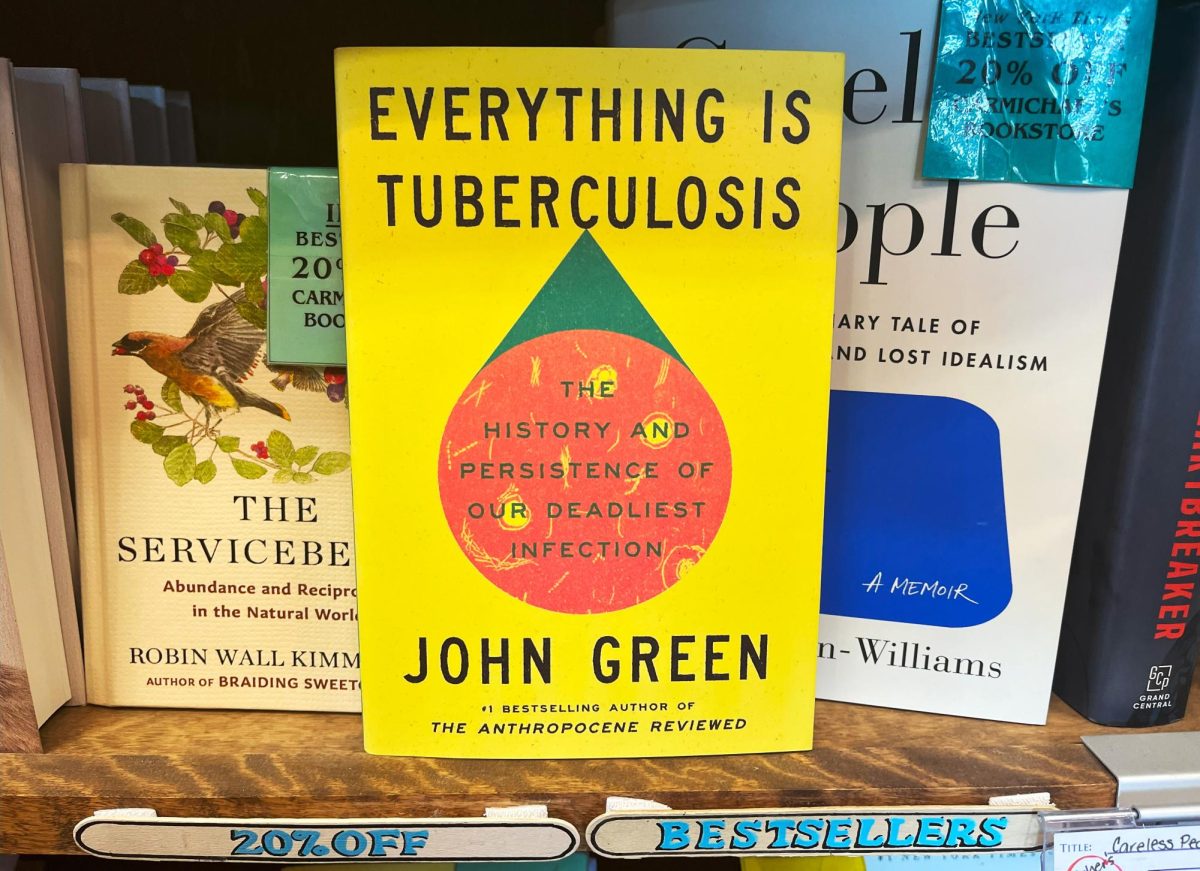In 1941, a magazine wrote that a cure for tuberculosis was something that was so far away as to practically be a dream. The cure was discovered just 12 years later. The revelation that humans are to predicting the future as elephants are to riding bicycles is one of the many takeaways of John Green’s newest—and slimmest—book, “Everything is Tuberculosis,” but after reading it, I had real and much-needed hope that the future may not have TB in it at all. As Green has joked in recent weeks, maybe one day he will be able to write a book called “Everything was Tuberculosis.”
It’s here that I should disclose something. The book could’ve been abysmal. It could’ve been convoluted, incomprehensible, poorly researched balderdash, and I would not have liked it, of course, but I at least would have understood it. This is because, for the last three or so years, I have been enthralled in the work of John Green and his brother Hank—a duo most famous for their educational video empire Complexly, responsible for SciShow and CrashCourse (among many other things).
My involvement with their sprawling online community (which calls itself “Nerdfighteria”) deserves its own essay, but I bring it up now to say that John Green has spent the last two years tying tuberculosis into everything tuberculosis could possibly be tied into. (Yes, all of those are individual hyperlinks.) For that reason, most of “Everything is Tuberculosis” was, at most, a refresh for me. This especially becomes true in the book’s best section, the ending, where Green explains the ways drug companies price-gouge the world’s poorest countries for TB medication—tbfighters.org has templates to call and email these companies to demand change, several of which I wrote or edited.
All of this is to say: take any notes about the book’s comprehensiveness with an ounce of skepticism. It’s also to say that, in reviewing this book, I’m inevitably also reviewing Green’s work in the fight against TB as a whole.
“Everything is Tuberculosis” starts with the tidbits. Tuberculosis is the reason clean-shaven men came into fashion. It gave us the state of New Mexico. “At a neighborhood Halloween party,” Green writes, “I’d confront a ten-year-old dressed as a cowboy: ‘Did you know tuberculosis helped give us the cowboy hat?’” For many years tuberculosis was also, incidentally, believed to be a disease that was inherited and particularly affected neurotic and sad-eyed writers. (The minutes between reading that and learning it was wrong were the most terrifying of my life.) There are two equal possibilities to explain why Green spends so many of the book’s precious early pages on these factoids, and the truth is probably some combination of the two.
The first is that it’s interesting. Tuberculosis is an arcane thing for anyone to be writing about, especially a young adult novelist and YouTuber. It helps to tangibly connect the disease to something that the reader doesn’t have to think too hard or observe too astutely to understand.
The second is that it’s marketable. No modern creative can have Green’s influence and not have to harness algorithms. In a media landscape where people understandably swipe away from the fiftieth fresh-cut horror they’ve seen that day, luring people in with the brand of a hapless writer talking about cowboy hats is probably the only way Green could keep them watching for the actually important parts.
And the book is not short of those. Green’s thesis is an elongated version of the title: tuberculosis is about everything and everything is about tuberculosis, from the ridiculous—long hemlines and Ringo Starr—to, as Green explores, the serious. “Everything is Tuberculosis” is evenly split between the history of TB and the story of one of its bearers: Henry Reider.
Reider is a Sierra Leonean boy whom Green met on a philanthropic trip in 2019. Green recounts how Reider, who looked to be about 9 and shares his name with Green’s son, was so lively and affable when he walked Green around the healthcare facility that Green thought he was the child of someone who worked there. He would later find out that Rider was a TB patient.
His doctor said that the antibiotics were working well enough to keep him energized, but not well enough to save him. Malnutrition had stunted his growth and TB had eaten away at the body that remained. He wasn’t 9. He was 17.
Green wrote, “There was a lot I didn’t understand.”
Stories like Reider’s are obviously horrifying, and Green makes it clear that we don’t have to accept a world where there will be more like them. Over the past years, he has marshaled an army of online “TBFighters” who have lobbied two major drug companies—Johnson & Johnson and Danaher—to lower their prices.
Johnson & Johnson was trying to extend their patent on the drug bedaquiline, which is personal for Green; a TB activist and fan of Green’s books died because the Indian government wouldn’t let her access the drugs. Danaher has been artificially increasing the prices of its GeneXpert test cartridges, which can test for TB (and other diseases like HIV) and say exactly which drugs will and won’t work.
The TBFighters’ pressure on these groups led to wins, with some asterisks. Johnson & Johnson agreed not to enforce its patent on bedaquiline anywhere. Danaher—the company against which I did most of my work as a “TBFighter”—lowered its cartridge prices by about 25%, but they promised to release an audit on how expensive they were to make and pledged to stop making a profit on them. This was well over a year ago. They have done neither.
It’s easy to come off as annoying in one’s righteousness about this issue, but tuberculosis urgently needs urgency.
Reider ended up surviving. He is a poet and has a delightful YouTube channel. But so many people just like him haven’t. It’s rare that nonfiction books will focus so heavily on just one person, but for a topic this distant from Green’s readers, it’s the exact right choice. It shows you that each of the 1.25 million people who die every year of TB—all of whom die even though there’s a cure because they can’t afford the treatment or testing—have lives as loaded with emotion and complexity as ours are. It’s an easy thing to write, but a much harder thing to prove; Green does both.
If you look at a chart of TB deaths, you find the rationale for the book’s central and propulsive hope. The line is going down. It’s not going down fast enough—we’ve had this cure since 1953, for God’s sake—but it is going down. It may not stay that way, though.
The cuts to USAID have been traumatic to healthcare providers for all diseases, but TB care has been uniquely ravaged. Where a strep infection may take 20 pills to cure, TB takes hundreds if not thousands. And, if more advanced testing (which many third-world hospitals don’t have) reveals that a patient’s TB is resistant to the drugs they’ve been taking, they have to start the whole process over.
If this is stopped at any point, the consequences will be catastrophic. If someone goes off their medication for even a couple weeks—because of, say, the suspension of the program that funded their treatment—TB has time to develop resistance, which makes the patient much more likely to die. It’s estimated that the Trump administration’s foreign aid cuts will kill as many as 2.6 million people over the next 10 years of TB alone.
That’s one of many enormous statistics being thrown around right now, but as Green has argued in recent weeks, it deserves special attention. We’re already in a race against time to find more drugs to cure drug-resistant TB, and if people are taken off their medicine, it won’t take long for a new strain of TB to emerge that we have no drugs to fight which will spread outside the third world and, eventually, kill people in rich countries, just like the TB of the not-too-distant past. Green wasn’t kidding when he said that everything is about tuberculosis, and it’s clear to anyone who reads this book that tuberculosis is our problem, too.








